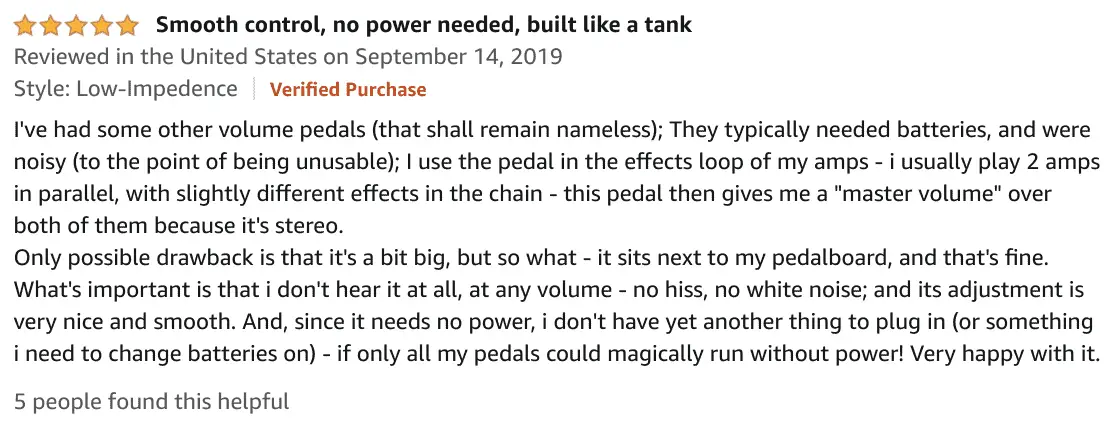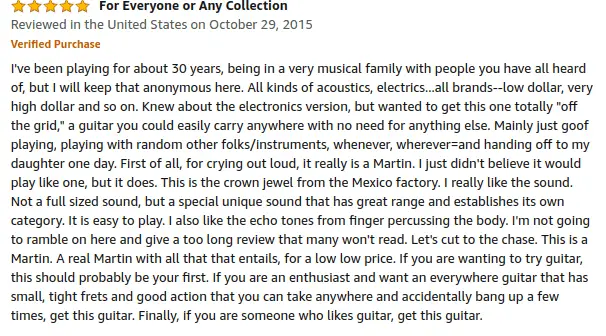For over a decade, the BOSS FV-300 was the industry standard for volume pedals. More recently, Boss, one of the leaders in guitar effect pedals industry, has upped the game with the FV-500H. With a simple design and durable design, this mono, high-impedance device is a popular option.
If you’re a guitarist, there aren’t a lot of options if you want to make a note swell or turn up the volume of your tone. But, you can use a volume pedal like this one, and even add lush sounds if you use it with a delay or reverb pedal.
However, if you’re not sure if this is the right pedal for you, we’ve got everything you need to know below.
Things to Consider Before Buying a Volume Pedal
Before you buy any volume pedal, there’s a few factors you should consider:
For musicians, purchasing a volume pedal like the BOSS FV-500H is almost necessary, especially if you’re experimenting with your sound. However, if you’re looking to add a lot of crazy effects with your volume pedal, you may want to opt for an active pedal over a passive one.
Make | Model | Details |
|---|---|---|
Boss | FV-500H |
Features and Benefits
Since we’ve covered the basics of what makes this pedal stand out from the rest, it’s time for a detailed review of the BOSS FV-500H’s features and benefits:
Features
One of the most noticeable features about this pedal is its construction. As far as volume pedals go, the FV-500H ranks on the large size. It’ll probably be bigger than anything else you’ve got on your pedalboard—and possibly more sturdy too. The aluminum casing on the outside of the pedal makes it a lot more durable, and less likely to get damaged if you accidentally drop it.
Keep in mind that the sturdy build also comes with a little bit of extra weight too. It weighs around 3 ½ pounds, which is a little bulky for a volume pedal.
As big as this pedal is, a lot of musicians don’t keep it on the pedalboard. If you’ve got a lot of other effect pedals, it may just be too tight of a squeeze. Instead, you’re probably better off leaving it beside the pedalboard.
Although it’s large, the 500H uses rubber to ensure that your foot grips the pedal well. Some volume pedals might be too slippery, and make it challenging to press down while you’re playing. With this one, you should be able to get a grip, whether you’re barefoot or wearing shoes.
You’ll also notice that this is a mono pedal, which means that it only uses a single input and output. As a result, you’ll only be able to connect one guitar to the pedal at a time, and you won’t be able to pair it with dual amps. This may be limiting for some users, but most musicians don’t need any more inputs.
There is, however, an expression out in this pedal that you can connect to an effect stompbox and control with the pedal. This makes the 500H fairly handy, since it can double as an expression pedal too.
There’s even a tuner out too, which may be convenient in certain circumstances. You can connect it to your tuner to help ensure that your guitar doesn’t go out of tune if you’re playing live.
As mentioned before, this is a passive volume pedal, so you don’t have to worry about external power supplies. While this makes the 500H somewhat limited on volume controls, it also makes it convenient as well. There’s no need to worry about replacing batteries, or the pedal losing power when the power supply starts to go bad.
Controls
If you’ve ever used a volume pedal before, you know that these devices don’t come with a lot of controls or variation. The BOSS FV-500H is no exception, although it does contain one more control than a lot of the competition.
The major control is the pedal itself. You change the volume of your tone by pressing the pedal down with your foot. But, there’s also a minimum volume knob that’s located on the side of the pedal too. The minimum volume can affect how much volume the pedal delivers when you’ve got it at its lowest setting or at its highest.
Depending on the way you use the minimum volume knob, you can make sure the volume pedal is still audible when you’ve got your foot in the volume down position. Or, make it less audible when it’s supposed to be at full volume.
Sound
As bulky as it is, you’d probably expect the 500H to sound a little clunky, or be difficult to get it to the volume you want. However, for many musicians, this pedal is smooth, and increases your volume without feeling too abrupt. You shouldn’t experience a lot of tone loss, either.
Since the resistance is adjustable, you can also figure out how challenging (or easy) you want the pedal to go down when you press on it. That’s a major perk for a lot of guitarists since you can always adjust the resistance if it doesn’t feel right. If you find that your volume increase is feeling too sudden, you can always add more resistance. Or, if you’re not getting enough change, just dial back on the resistance.
If you find that you’d like to operate the pedal in expression mode, it sounds just fine there too. The 500H still remains just as smooth, and is easy to control.
Social Proof of the Pedal
Although we think this pedal has some great perks that come with it, you don’t need to just listen to us! Plenty of other people agree, and have offered their own feedback about the pedal.

For instance, the user above touched on a lot of topics that we’ve covered in this review. While the pedal’s size is a little bulky, it doesn’t sacrifice that smooth control. Plus, there’s the added perk that you don’t have to rely on batteries or an external power source. There’s no hassle, or ever any stress about whether it’s time to replace the batteries.

As another reviewer found, there’s not a lot that can go wrong with this pedal, or any other volume pedal. As long as it offers a smooth control, creates the swell set that you want, and isn’t too fragile, most musicians are happy.

If you tend to be a little rougher on your pedals, you’ll probably appreciate the sturdy design and aluminum casing like the user below did.

We also aren’t the only ones who appreciated the adjustable resistance on the pedal, either. While you might find that it feels right once you take it out of the box, it’s nice to have the option to adjust if you ever need to. As mentioned before, you may find, like the user above, that it’s easier to store the pedal on the side than on your pedalboard.
In Conclusion
As nifty as volume pedals can be, you want to make sure they sound smooth, and that they aren’t too slippery to press down on. And, like any pedal, you want to make sure they’re sturdy enough to last the test of time. The BOSS FV-500H excels in all of those categories, and has a robust design that shouldn’t break anytime soon. Interested in trying this pedal out?
Click below to check out !!




